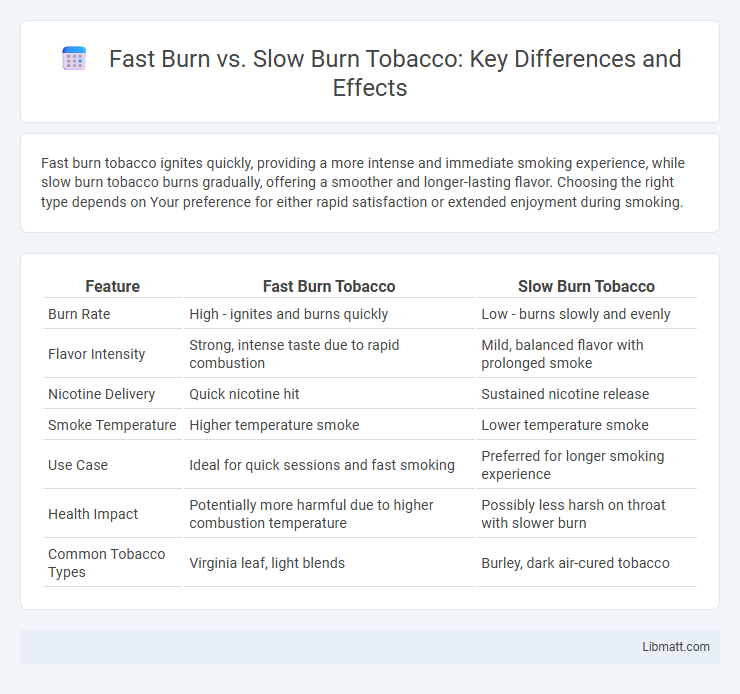Fast burn tobacco ignites quickly, providing a more intense and immediate smoking experience, while slow burn tobacco burns gradually, offering a smoother and longer-lasting flavor. Choosing the right type depends on Your preference for either rapid satisfaction or extended enjoyment during smoking.
Table of Comparison
| Feature | Fast Burn Tobacco | Slow Burn Tobacco |
|---|---|---|
| Burn Rate | High - ignites and burns quickly | Low - burns slowly and evenly |
| Flavor Intensity | Strong, intense taste due to rapid combustion | Mild, balanced flavor with prolonged smoke |
| Nicotine Delivery | Quick nicotine hit | Sustained nicotine release |
| Smoke Temperature | Higher temperature smoke | Lower temperature smoke |
| Use Case | Ideal for quick sessions and fast smoking | Preferred for longer smoking experience |
| Health Impact | Potentially more harmful due to higher combustion temperature | Possibly less harsh on throat with slower burn |
| Common Tobacco Types | Virginia leaf, light blends | Burley, dark air-cured tobacco |
Introduction to Fast Burn and Slow Burn Tobacco
Fast burn tobacco ignites quickly and produces a higher temperature, leading to a more intense flavor and faster consumption. Slow burn tobacco, by contrast, burns at a lower temperature, allowing for a longer smoking experience with milder taste and reduced harshness. Understanding the combustion rate is essential for selecting the right tobacco type based on smoking preferences and desired flavor profiles.
Understanding Burn Rates in Tobacco
Understanding burn rates in tobacco is essential for an optimal smoking experience, as fast burn tobacco ignites quickly and burns hotter, resulting in a shorter smoking duration and potentially harsher flavor. Slow burn tobacco, conversely, smolders more steadily, providing a longer-lasting session with more controlled flavor release and reduced chemical buildup. Your choice between fast and slow burn tobacco influences not only the taste and duration but also the intensity and smoothness of the smoke.
Key Differences Between Fast Burn and Slow Burn Tobacco
Fast burn tobacco ignites quickly and produces a rapid, intense smoke, often preferred in cigarettes that require a quick start and consistent burn. Slow burn tobacco burns more slowly, providing a longer-lasting smoking experience with cooler smoke and enhanced flavor retention. The key differences lie in burn rate, smoke temperature, and flavor complexity, influencing user preference and tobacco product design.
Chemical Composition and Additives
Fast burn tobacco typically contains higher levels of chemical additives and combustion accelerants, designed to enhance ignition and sustain rapid burning, which can increase the release of harmful substances such as tar and carbon monoxide. Slow burn tobacco has fewer additives and a formulation meant to regulate the burning rate, resulting in a cooler, longer-lasting smoke with potentially reduced exposure to some toxic chemicals. Your choice between fast and slow burn tobacco impacts the chemical composition of the smoke you inhale, influencing health risks and smoking experience.
Impact on Flavor and Smoking Experience
Fast burn tobacco tends to produce a more intense and immediate flavor, often resulting in a harsher smoking experience with a stronger nicotine hit. Slow burn tobacco enhances flavor complexity and allows for a smoother, longer-lasting smoke, offering a richer and more nuanced tasting experience. The burn rate directly influences the interaction of heat with tobacco oils and sugars, shaping the overall aroma and satisfaction for the smoker.
Health Risks: Fast vs Slow Burn Tobacco
Fast burn tobacco increases exposure to harmful chemicals like tar and carbon monoxide, leading to higher risks of respiratory diseases and cardiovascular problems. Slow burn tobacco produces lower levels of these toxic substances, potentially reducing but not eliminating the health risks associated with smoking. Both types contribute significantly to cancer, lung disease, and addiction due to the presence of carcinogens and nicotine.
Popular Uses and Consumption Methods
Fast burn tobacco is commonly used in roll-your-own cigarettes and cigars due to its rapid ignition and intense flavor, appealing to smokers seeking quick satisfaction. Slow burn tobacco is preferred for pipe smoking and premium cigars, valued for its extended burn time and cooler, more nuanced taste experience. Consumption methods vary, with fast burn tobacco favored for convenience and portability, while slow burn tobacco suits leisurely smoking sessions.
Factors Influencing Burn Rate
Tobacco burn rate is influenced by factors such as moisture content, leaf type, and paper porosity, with faster-burning tobaccos typically having lower moisture and thinner, more porous papers. Chemical composition, including sugar and nicotine levels, also affects combustion speed by altering how quickly the tobacco ignites and sustains a burn. Environmental conditions like humidity and airflow play a crucial role in modulating the burn rate, impacting the smoking experience and flavor profile of both fast and slow burn tobacco products.
Consumer Preferences and Trends
Consumer preferences reveal a growing shift towards slow burn tobacco due to its prolonged flavor intensity and reduced frequency of use, which appeals to those seeking a more controlled and enjoyable smoking experience. Fast burn tobacco remains popular among users who prioritize convenience and quicker consumption, often favoring robust and immediate flavor impact. Your choice may depend on lifestyle and taste preferences, influenced by emerging trends promoting health consciousness and premium tobacco products.
Choosing the Right Tobacco for Your Needs
Fast burn tobacco ignites quickly and releases flavor rapidly, making it ideal for smokers seeking a more intense and immediate smoking experience. Slow burn tobacco offers a longer-lasting smoke with gradual flavor release, preferred by those who enjoy extended smoking sessions and a smoother taste. Selecting the right tobacco depends on personal smoking habits, desired flavor intensity, and session duration preferences.
Fast burn vs slow burn tobacco Infographic

 libmatt.com
libmatt.com